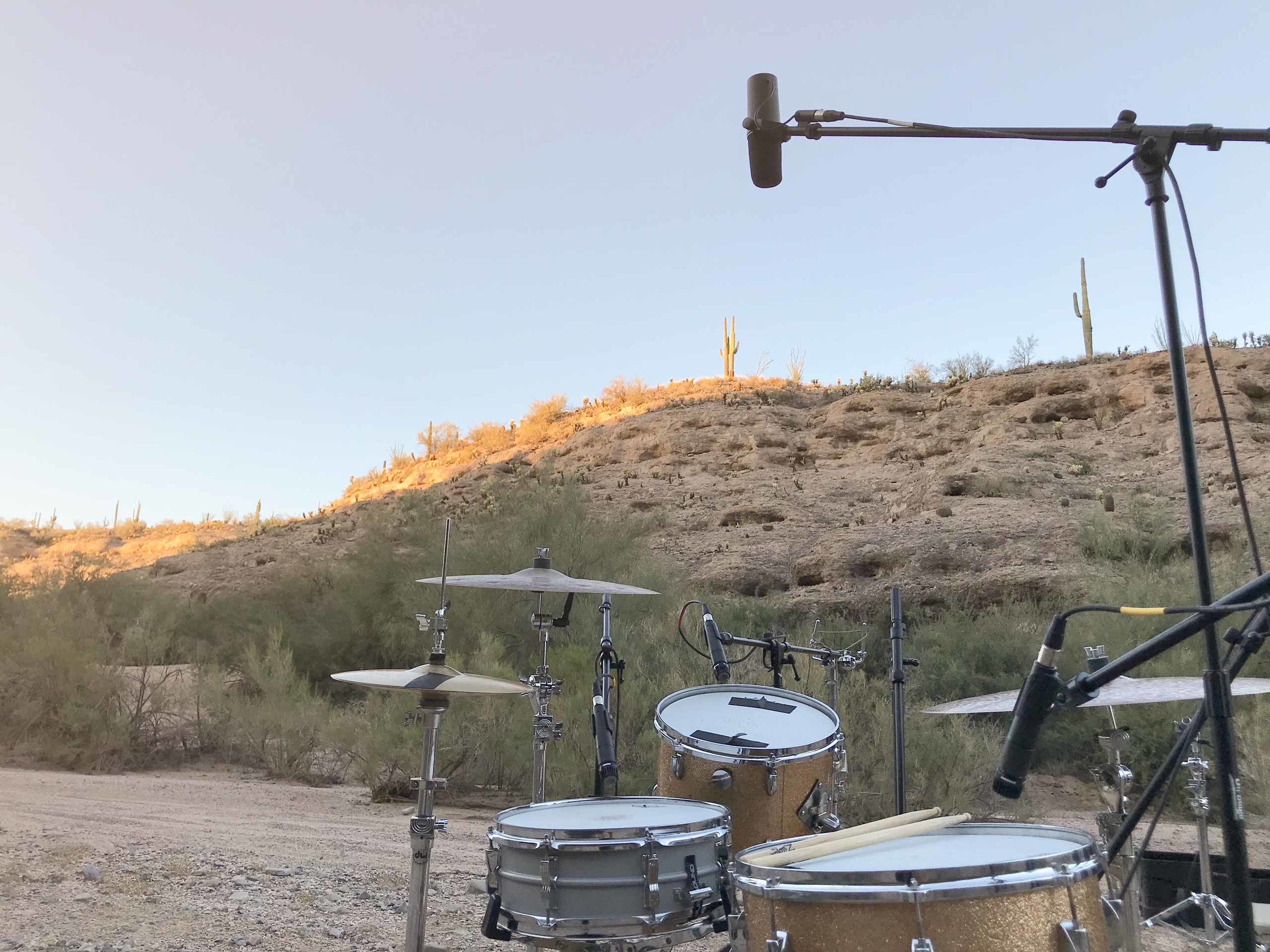Recording Drums Outside
Making Of The Desert Library
Our 1960’s Gretsch In Tonto National Forest.
The Idea
When it comes time to brainstorm new ideas for sample libraries, we try to think of things that have not been done (or done well). This could be anything from recording in a garage to sampling one of the first drum machines. In the most recent case we found ourselves asking the following question:
“What does the desert sound like?”
There are a handful of awesome studios in the desert (which we contemplated booking time at) but that didn’t feel right. We wanted sounds that were truly wild and unpredictable and to have a sense of real ambience.
Since this recording was so uniquely different, we wanted to share some insight into the process.
The Desert
We recorded the Desert library in Tonto National Forest, just northeast of Scottsdale, Arizona.
The Forest Service describes Tonto as:
“3 million acres of rugged and spectacularly beautiful country, ranging from Saguaro cactus-studded desert to pine-forested mountains”.
This is a near perfect summation.
The first time I ever walked into Tonto, I immediately felt at home. The sheer size, beauty and diversity of this desert is awesome - in the truest sense of the word. It is also relatively unknown (aka a perfect place to bang some drums in the middle of the day).
Everything here is completely wild.
Things we didn’t expect:
Drums bouncing against canyon walls
Crickets in “room” mics
Sun warped cymbal sounds
Completely dead drum tones
This unpredictability is precisely what drew us to record here. More on this later.
The downside? Nearly everything here wants to kill you. The heat will force you to withdraw to the shade, the sun is blinding and scorpions and snakes are lurking everywhere.
When you add recording equipment, vintage drums (and mezcal hangovers) you can begin to imagine what we endured.
Hiding from the encroaching sun.
“The desert is so dead, yet so alive - it almost defies logic.”
We ended up tracking in five different locations. These areas ranged from completely flat and wide open terrain to being nestled in long canyons with lots of reflective surfaces. The sonic characteristics of each spot varied greatly.
Click and zoom on each recording location below (marked in orange) to learn more.
We brought mics, stands, drums, a recording interface and hardware to all of these locations. Tracking spots had to be somewhat accessible by vehicle. Luckily, we were able to find dry riverbeds and fire access roads that allowed our Suburban to make its way into some pretty harsh territory. The car did not come out unscratched.
Circles engineer Tyler Lindgren manning the field recorder.
The Gear
In doing research for field recording gear, we began to see patterns in recommended mics and interfaces. The main recording rig we decided on was the Zoom F8N (2018 Edition).
We were quite impressed with this thing. The F8N had very little noise and the preamps were ultra clean with little added character. This was good, as we would be processing heavily later. The carrying case allowed us to be completely mobile and the batteries lasted for an impressive amount of time given the heat and use.
The back of the Suburban was our primary listening location. We used headphones to monitor levels and audition mic placements. We sent out a 50 ft snake to the drums.
The Mics
For close mics, we went for the classics: Shure SM57, SM58, Sennheiser 421.
In lieu of standard stereo overheads, we decided to go full mono overhead. The SM7B absolutely rules in this capacity. It has a lot of body while still providing accurate detail of the kit.
The SM58 on the kick beater side was another great sounding mic placement.
Since there are very little reflections outside, it gives the drums a supremely dry and dead quality. Hence the reason these close mics sound like we were in an isolation booth.
Reflections define the sonic characteristics of a space. When there are no walls, things start to get very weird.
Sounds Just Keep Going Up And Away
Our vibe mics for the session were a Webcor harmonica mic from the 1950’s and a 1960’s German made Peiker mic. The idea behind these mics was that they allowed us to synthesize the natural weirdness of desert, without using any processing.
1960’S Peiker mic pointed directly at the side of the snare
Our main “room” mic we used was the Rode NTG-3 shotgun mic with a windscreen blimp. This was a crucial part of the mic arsenal.
The Shotgun mic allowed us to get distance from the source (drum kit) while still being highly directional and receiving only the information from where it is pointed. This helped eliminate ambient noise.
Conversely, when pointed away from the drums, we received extremely tight delayed reflections from the canyon walls.
This 300+/- ms delayed reflection from a canyon wall, gives you a weird “Zeppelin in the desert” effect. It’s a real, natural delay.
Sonically, the Desert is so dead and so alive, it almost defies logic.
Out in the field with the Shotgun Mic & Webcor
The shotgun mic also proved to be very versatile for our standalone field recordings of chains, stomps and cactus bones. The windscreen blimp has a micro-filter protective lining, so we could bury this thing anywhere and not be too concerned about it.
Our “woah” mic of the session was… drum roll… the iPhone. Yes, really.
You know when you listen back to a voice memo of a song, or a video of a live show and it sounds oddly good and compressed? Well, the same thing happened during this session. All of the videos of the drums made them sound absolutely HUGE. We started placing our iPhones at varying distances from the drums, and occasionally we would stuff them in nooks (far enough way that our snake wouldn’t reach).
These voice memos were later converted and added to the sessions.
Hear the crickets in all their glory:
Fortunately, there was minimal ambient noise during recording. On occasion, a gust of wind, a plane or a noisy Cicada halted sampling.
See below our aggressive response.
WARNING NSFW. STRONG ANTI-CICADA LANGUAGE.
As I previously mentioned, we kept this recording very mono. Typically, we would be using one mono overhead mic (SM7B), one close “room” mic and one far “room” mic (Shotgun and/or iPhone). We attempted some wide SM57 “rooms” for the dead lizard kit, but the imaging didn’t seem to make much of a difference.
The desert just wanted to be mono.
“Reflections define the characteristics of a space. When there are no walls and no reflections, things start to get very weird.”
The Drums
For this session, we kept the amount of drums we sampled very minimal. This was mostly due to the logistics of hauling gear miles into the hellscape of Tonto. Our main kit was a 1960’s Round Badge Gretsch. None of us had really used Gretsch stuff before, so this was fun to switch it up. Our snare was a 1970’s Ludwig Acrolite.
Cymbals were a 24” Meinl Big Apple Byzance Jazz Ride and a 20” Meinl Byzance Extra Dry Thin Crash. We opted for cymbals with shorter decay times. Cymbals take the most time to sample due to the fact that they ring for what seems like a never ending amount of time. Shorter sustain is ideal, especially in the heat. The Byzance series also has that dirty, desert quality we were after.
Note: Don’t touch cymbals when they’ve been out in the sun
It was 110 degrees during the peak hours. This would inevitably cause the drum heads to warp and detune very quickly. You could argue that this added to the vibe.
The first day out in the field nearly gave us all heat strokes. The desert is no joke. During the afternoon downtime, we were able to get some field recordings on the partially shaded ranch where we were staying.
Circles Engineer Stefan Runstrom Evaluating Sounds In The Mobile Studio
Another unique aspect to this recording was that there were no screens to look at while we were recording. This gave us one less sensory input and allowed more focus on the sounds themselves. Old school.
The Mixing
This recording was obviously very special, so we did not want to skimp on the mixing process. We got these sounds mixed by Andrew Berlin at The Blasting Room Studios in Fort Collins, CO.
Pretty cool to hear drums and cactuses through an SSL, Un-Fairchild, UTA EQ, Standard Audio Level-Or & Stretch, 1176’s among other things.
Circles Desert was mixed using almost exclusively all analog outboard gear. This obviously makes a huge difference in how everything sounds but it also limits over-processing.
This library was truly a feat for us. Nothing like this had been attempted on this scale before. Playing loops while taking in fresh air at sunset in the middle of a desert will inspire anyone. Yea, we’re hippies, get over it.
The word “vibe” should be banned from music, but man, this place had a great vibe.
We hope you enjoy creating music with these sounds as much as we enjoyed making them.
Visit The Circles Desert Product Page HERE.
Ah, the desert.












